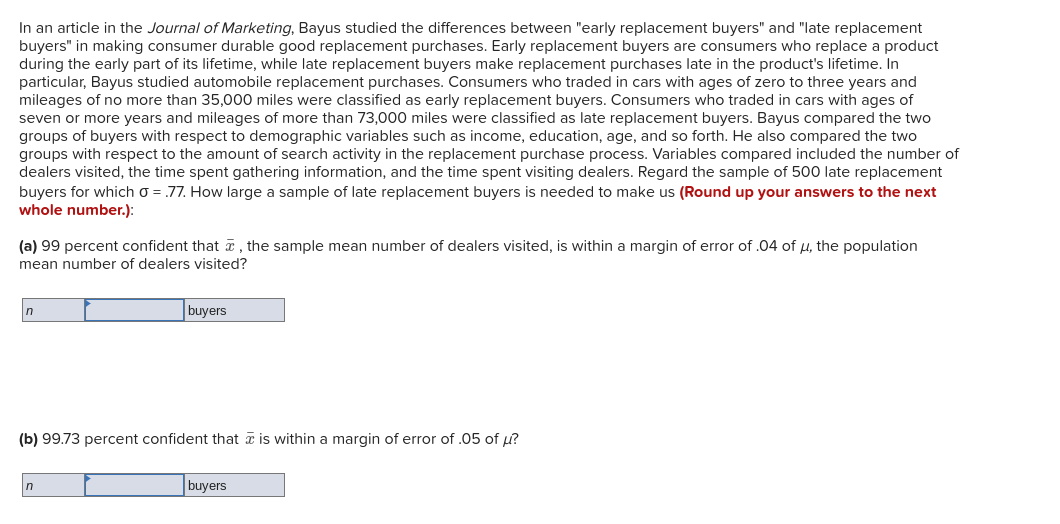n an article in the Journal of Marketing, Bayus studied the differences between "early replacement buyers" and "late replaceme uyers" in making consumer durable good replacement purchases. Early replacement buyers are consumers who replace a pro luring the early part of its lifetime, while late replacement buyers make replacement purchases late in the product's lifetime. In articular, Bayus studied automobile replacement purchases. Consumers who traded in cars with ages of zero to three years ar hileages of no more than 35,000 miles were classified as early replacement buyers. Consumers who traded in cars with ages even or more years and mileages of more than 73,000 miles were classified as late replacement buyers. Bayus compared the roups of buyers with respect to demographic variables such as income, education, age, and so forth. He also compared the tv roups with respect to the amount of search activity in the replacement purchase process. Variables compared included the nu lealers visited, the time spent gathering information, and the time spent visiting dealers. Regard the sample of 500 late replace uyers for which o = .77. How large a sample of late replacement buyers is needed to make us (Round up your answers to the vhole number.): a) 99 percent confident that a , the sample mean number of dealers visited, is within a margin of error of .04 of u, the populatie hean number of dealers visited? buyers
n an article in the Journal of Marketing, Bayus studied the differences between "early replacement buyers" and "late replaceme uyers" in making consumer durable good replacement purchases. Early replacement buyers are consumers who replace a pro luring the early part of its lifetime, while late replacement buyers make replacement purchases late in the product's lifetime. In articular, Bayus studied automobile replacement purchases. Consumers who traded in cars with ages of zero to three years ar hileages of no more than 35,000 miles were classified as early replacement buyers. Consumers who traded in cars with ages even or more years and mileages of more than 73,000 miles were classified as late replacement buyers. Bayus compared the roups of buyers with respect to demographic variables such as income, education, age, and so forth. He also compared the tv roups with respect to the amount of search activity in the replacement purchase process. Variables compared included the nu lealers visited, the time spent gathering information, and the time spent visiting dealers. Regard the sample of 500 late replace uyers for which o = .77. How large a sample of late replacement buyers is needed to make us (Round up your answers to the vhole number.): a) 99 percent confident that a , the sample mean number of dealers visited, is within a margin of error of .04 of u, the populatie hean number of dealers visited? buyers
Glencoe Algebra 1, Student Edition, 9780079039897, 0079039898, 2018
18th Edition
ISBN:9780079039897
Author:Carter
Publisher:Carter
Chapter10: Statistics
Section10.6: Summarizing Categorical Data
Problem 27PPS
Related questions
Question

Transcribed Image Text:In an article in the Journal of Marketing, Bayus studied the differences between "early replacement buyers" and "late replacement
buyers" in making consumer durable good replacement purchases. Early replacement buyers are consumers who replace a product
during the early part of its lifetime, while late replacement buyers make replacement purchases late in the product's lifetime. In
particular, Bayus studied automobile replacement purchases. Consumers who traded in cars with ages of zero to three years and
mileages of no more than 35,000 miles were classified as early replacement buyers. Consumers who traded in cars with ages of
seven or more years and mileages of more than 73,000 miles were classified as late replacement buyers. Bayus compared the two
groups of buyers with respect to demographic variables such as income, education, age, and so forth. He also compared the two
groups with respect to the amount of search activity in the replacement purchase process. Variables compared included the number of
dealers visited, the time spent gathering information, and the time spent visiting dealers. Regard the sample of 500 late replacement
buyers for which o = .77. How large a sample of late replacement buyers is needed to make us (Round up your answers to the next
whole number.):
(a) 99 percent confident that ¤ , the sample mean number of dealers visited, is within a margin of error of .04 of u, the population
mean number of dealers visited?
n
buyers
(b) 99.73 percent confident that a is within a margin of error of .05 of u?
buyers
Expert Solution
This question has been solved!
Explore an expertly crafted, step-by-step solution for a thorough understanding of key concepts.
This is a popular solution!
Trending now
This is a popular solution!
Step by step
Solved in 2 steps with 4 images

Knowledge Booster
Learn more about
Need a deep-dive on the concept behind this application? Look no further. Learn more about this topic, statistics and related others by exploring similar questions and additional content below.Recommended textbooks for you

Glencoe Algebra 1, Student Edition, 9780079039897…
Algebra
ISBN:
9780079039897
Author:
Carter
Publisher:
McGraw Hill

Glencoe Algebra 1, Student Edition, 9780079039897…
Algebra
ISBN:
9780079039897
Author:
Carter
Publisher:
McGraw Hill